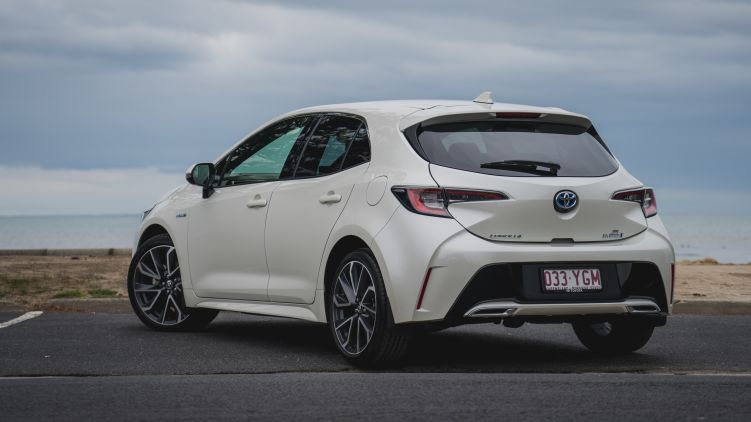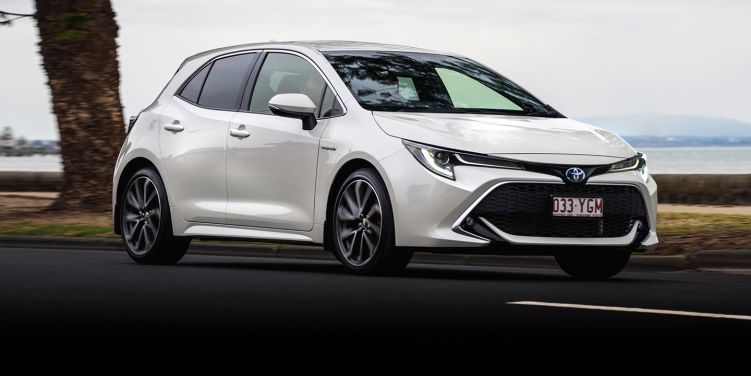Toyota Corolla hybrid review: The good, the bad and the price tag
When it comes to saving fuel, tech prestige brands often make a big deal of their upcoming advancements. All the while, Toyota has been quietly feeding petrol-electric hybrids into the market – putting its money where its mouth is.
Hybrid tech has gone from stereotypically green in the Prius to mainstream fleet favourite in the Camry. After a toe in the water with the previous generation of the Corolla, the new-generation small car comes with the model’s widest hybrid availability yet.
Encompassing all three Corolla variants (Ascent Sport, SX and ZR), the new hybrid blends the sharp looks of Toyota’s all-new small hatch with the reduced fuel bills of the Prius, but sidelines the stigma of being a tree-hugging weirdo.
In top-tier ZR trim, Toyota delivers a flagship Corolla with the kind of flair that seems to have buoyed the success of cars like the Mazda 3. Form takes precedence over function with an aggressive styling package and big alloy wheels to grab your attention.
Yet for all of that, the most expensive Corolla you can buy is far from the most expensive small hatch on sale in Australia. In fact, at $31,870 plus on-road costs it’s actually quite decently priced. The step up to a hybrid makes up $1,500 of that price (a regular petrol-engine Corolla ZR is $30,370), which is a very reasonable upgrade.
Common to all new Corolla hybrid variants is a standard features list incorporating LED headlights with auto high beam, dual-zone climate control, keyless entry and ignition, adaptive cruise control, lane-departure warning with steering assist, autonomous emergency braking with pedestrian and cyclist detection, and an 8.0-inch touchscreen infotainment system.
Not a bad list on its own, and bolstered in the ZR with features including wireless phone charger, satellite navigation and digital radio, 18-inch alloy wheels, leather and suede-look sports seats, front seat heating, head-up driver display, 7.0-inch digital instrument display, blind-spot monitoring and eight-speaker JBL premium audio.
There’s plenty to like in that list, but a few minor irritations in terms of missing spec – like no front or rear park sensors (there’s a camera at the rear, but corner sensors would still be handy), no sunroof (previously an option), no powered or cooled front seats, and no smartphone connectivity for Apple CarPlay or Android Auto despite being available overseas.
None of those missing features are deal-breakers, but most are at least available as an option, if not standard, on competitors. There’s room in the range for an even-more luxe model above the ZR it seems, but Toyota knows its customers – and obviously doesn’t want to tread on the Camry’s toes.
Under the skin, the Corolla adopts the GA-C platform from the Toyota New Global Architecture (TNGA) modular chassis family, bringing with it improved rigidity, lower noise, and a lower centre of gravity for better handling.
Though it may be a near-new architecture, packaging doesn’t appear to be a strong suit, with a rear seat that’s quite compact compared to the outgoing Corolla hatch. Rear seat passengers do get ventilation outlets in the rear of the console at least.
Boot space isn’t class-leading either, although the ZR hybrid has the largest boot of the Corolla hatch range at 333 litres compared to 217L for other models, owing to a lower boot floor beneath which is a tyre sealant kit in lieu of a full-size or space-saver spare.
Given Corolla’s popularity around all parts of Australia, and not just in major city centres, the omission of a spare tyre (even a temporary one) seems dangerous and foolish. Call me jaded, but given the ease with which a sidewall can disintegrate on a flat low-profile tyre, I’d rather have a physical spare to put on than a suddenly useless can of goo.
Otherwise, the interior is an impressive place in which to spend time. The design is modern and quite striking, particularly with the sporty red and black ZR seats. Fit and finish are typically Toyota precise, and controls are sensibly grouped.
There’s a bit of a disconnect between the high-quality look and feel of the dash, and the pieced-together door cards that don’t convey the same sort of sophisticated design you’d find in a Camry, but it’s a small gripe unlikely to upset too many customers.
The Corolla’s new hybrid system differs slightly from its predecessor, with total system output reduced slightly and rated at a combined 90kW from a 72kW/142Nm 1.8-litre Atkinson-cycle four-cylinder petrol engine paired with two electric motor-generators with a 53kW/163Nm output.
There’s no need to plug in, as the Corolla hybrid can either generate its own electricity via the motor-generator, or store recuperated energy generated during deceleration in a 6.5Ah nickel-metal hydride battery pack.
Toyota has made changes to the way the two power systems co-operate resulting in smoother, quieter running. Electric-only power at low speeds, or electric assistance under heavy acceleration, ensure fuel consumption stays low with the petrol engine cutting in and out when required with barely a murmur to indicate it’s joined the race.
That means you simply get in the Corolla and drive it like you would any conventional car. There’s nothing extra to do and no new behaviours to learn. Toyota claims fuel consumption of 4.2L/100km, while on test we recorded a still decent 5.1L/100km.
Dynamically, the Corolla displays new-found flair. It’s still not a corner-carving delight ready to rival hot hatches, but the steering feels more connected and eager than before, with sharp turn-in and level, composed cornering.
There’s a lane-centring function amongst the Corolla’s suite of features, designed to keep the car between lane markings, but its stubborn insistence on keeping the car exactly centred results in constant tugging of the wheel against the driver’s direction. It’s utterly frustrating but easy to turn off – hopefully Toyota can revise it to be less intrusive.
The hybrid’s CVT auto isn’t the usual belt-type typically found in small cars, but rather a planetary gear set allowing the powertrain control module to seamlessly balance the contribution made by both petrol and electric systems. It also helps avoid some of the droning that usually affects CVT automatics.
Occasionally, there’s a quick moment of hesitation as the petrol engine starts up in driving scenarios where the Corolla has been running in EV mode. You’ll notice it most if you ask for more acceleration suddenly.
As the electric side of operation is so quiet and smooth (there’s literally nothing to hear), there are times when the petrol engine can rudely interrupt. Particularly at high revs, or under load when the petrol engine is solely driving the generator to charge the on-board battery, resulting in an off-beat vibration.
Read more: Everything Toyota
Even with dual powertrains, there is no big reserve of power to draw on either – not that the Corolla is positioned as any kind of performance machine. Undemanding drivers will likely be happy with what they get, but a decent reserve to fall back on for swift overtaking and the like would be very handy.
With urban use a particular focus of the new Corolla, it’s a little disappointing to find the low-speed ride tends to pogo over minor bumps, giving the Corolla a bouncy ride. Pick up the pace on the freeway, though, and the car becomes more settled.
The ride isn’t as plush as lower-grade cars on smaller wheels, but even on 18-inch wheels the Corolla never crashes through potholes or rides uncomfortably.
All Corolla hatch variants, regardless of engine, now feature 12 months or 15,000km service intervals, with the first four visits costing a very reasonable $175 each including all scheduled fluids and filters under the Toyota Service Advantage capped-price program.
Toyota now trails the majority of mainstream brands in Australia, however, with a three-year/100,000km warranty instead of the five-year plans offered by Hyundai, Ford, Mazda, Honda and more.
Toyota can obviously see the threat from rival small hatches. Some competitors, like Kia and Hyundai, have come a long way in a short time, while others, like Volkswagen and Mazda, have made a play for a more premium market segment.
The new Corolla ensures it can keep pace with those competitors, and any looming new challengers that might pop up. No new ground has been broken here, but it’s refreshing to see Toyota make a concentrated effort to improve dynamics and create a more energetic styling language.
It’s also good to see a frugal alternative powertrain in use. Not a work of science fiction, but a plausible, workable alternative. Hybrid tech may not be everyone’s cup of tea, but with diesel engines on the nose, now is the time for Toyota’s efforts to shine.
For all its improvements, the Corolla is still, first and foremost, a Corolla. That means there are no complex new systems for traditional owners to learn or adapt to, just get in and drive. That kind of familiarity is worth its weight in gold.








 Proudly Australian owned and operated
Proudly Australian owned and operated